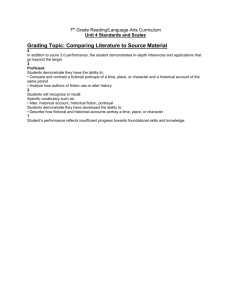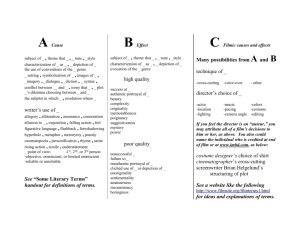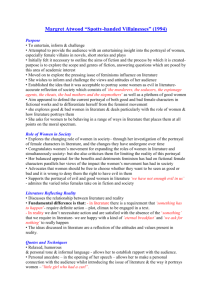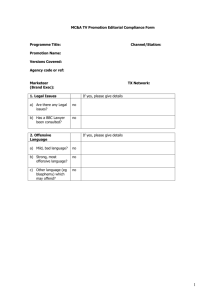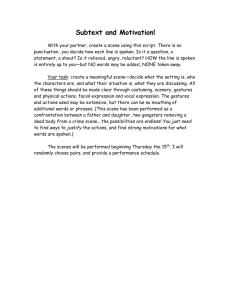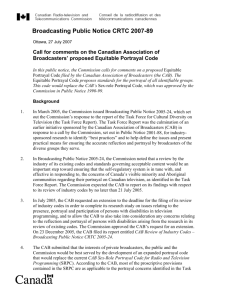The Game “Portrayal” as a Classroom Tool
advertisement
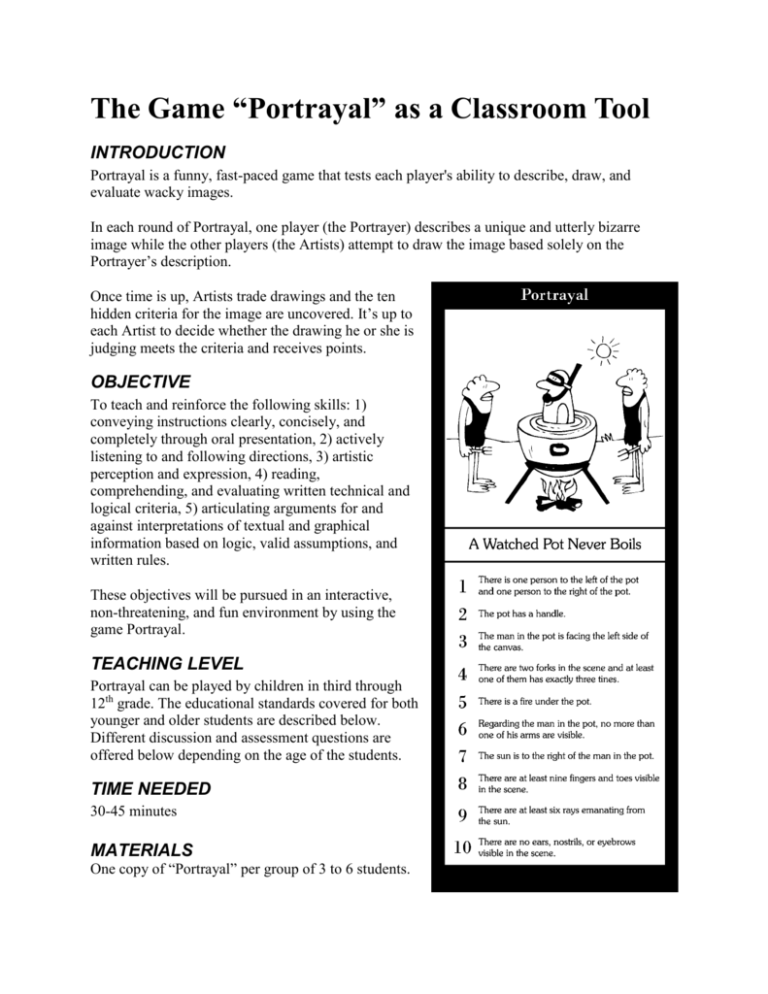
The Game “Portrayal” as a Classroom Tool INTRODUCTION Portrayal is a funny, fast-paced game that tests each player's ability to describe, draw, and evaluate wacky images. In each round of Portrayal, one player (the Portrayer) describes a unique and utterly bizarre image while the other players (the Artists) attempt to draw the image based solely on the Portrayer’s description. Once time is up, Artists trade drawings and the ten hidden criteria for the image are uncovered. It’s up to each Artist to decide whether the drawing he or she is judging meets the criteria and receives points. OBJECTIVE To teach and reinforce the following skills: 1) conveying instructions clearly, concisely, and completely through oral presentation, 2) actively listening to and following directions, 3) artistic perception and expression, 4) reading, comprehending, and evaluating written technical and logical criteria, 5) articulating arguments for and against interpretations of textual and graphical information based on logic, valid assumptions, and written rules. These objectives will be pursued in an interactive, non-threatening, and fun environment by using the game Portrayal. TEACHING LEVEL Portrayal can be played by children in third through 12th grade. The educational standards covered for both younger and older students are described below. Different discussion and assessment questions are offered below depending on the age of the students. TIME NEEDED 30-45 minutes MATERIALS One copy of “Portrayal” per group of 3 to 6 students. EDUATIONAL STANDARDS COVERED For Grades 3 through 5 English and Language Arts Give precise directions and instructions Emphasize points in ways that help the listener to follow important ideas Use volume, pitch, phrasing, pace, modulation, and gestures appropriately to enhance meaning and comprehension Analyze and interpret instructions that are organized in logical sequential order Follow simple multiple-step written and verbal instructions Mathematics and Science Use numerical data and measurements in describing and comparing objects, such as length, area, volume, position, quantity, distance, and proportion Identify, describe, and classify polygons (including triangles, quadrilaterals, pentagons, hexagons, and octagons) Understand and utilize geometric concepts such as parallel, perpendicular, radius, diameter, congruent, symmetric Analyze problems by identifying relationships, distinguishing relevant from irrelevant information, sequencing and prioritizing information, and observing patterns Determine when and how to break a problem into simpler parts Use estimation as a strategy for conveying quantitative and qualitative information Visual and Performing Arts Identify and describe elements of art, emphasizing line, shape/form, texture/pattern, space, and value Use one-point perspective to create the illusion of space Use linear perspective to depict geometric objects in space For Grades 6 through 12 English and Language Arts Use simple, compound, and compound-complex sentences Restate and execute multiple-step oral instructions and directions Emphasize salient points to assist the listener in following the main ideas and concepts Use audience feedback (e.g., verbal and nonverbal cues) to rephrase, summarize, or modify the organizational structure of verbal presentation to clarify the meaning Report information and structure ideas in a coherent, logical fashion; use precise language; offer detailed and accurate specifications Evaluate the clarity, quality, effectiveness, and general coherence of a speaker's important points, evidence, organization of ideas, delivery, diction, and syntax Deliver expository presentations; anticipate and address the listener's potential misunderstandings, biases, and expectations Use technical terms and notations accurately and for specificity Mathematics and Science Analyze problems by identifying relationships, distinguishing relevant from irrelevant information, identifying missing information, sequencing and prioritizing information, and observing patterns Determine when and how to break a problem into simpler parts Visual and Performing Arts 1. Identify and describe all the elements of graphical art (e.g. shape/form, line, texture/pattern, space, value, symmetry) 2. Identify and describe scale (proportion) as applied to two-dimensional images 3. Use various observational drawing skills to depict a variety of subject matter PROCEDURES 1. Divide the class into groups of four to six. Following the rules of Portrayal, give each student a couple of score sheets and a writing utensil. 2. Review the rules of the game and the purpose of the score sheets, concealment folder, timer, and method of scoring. It may help to use one scene card as an example and demonstrate for the class how one might describe the scene on the card so that other students are able to draw the scene solely from the description given. 3. Allow the students to play the game, monitoring the groups and mediating any rule questions or disagreements regarding interpretation of the criteria. 4. Allow the game to continue as long as time will allow. You may allow the students to continue the game during the next class session if you are willing to record the current scores of the groups. GRADES 3-5 QUESTIONS FOR DISCUSSION 1. 2. 3. 4. What occupations require people to be able to give clear instructions? What occupations require people to be able to follow instructions? What are some techniques that the Portrayer could use to improve his/her instructions? What are some techniques that the Artists could use to improve his/her ability to draw the scene accurately? 5. Is it harder to be a Portrayer or an Artist? Why? GRADES 6-12 QUESTIONS FOR DISCUSSION 1. What are examples of one-way and two-way flows of information in society? 2. What are some examples where limiting the flow of information (not allowing for feedback or asking of questions) would be desirable? 3. What are some ways that diversity (differences in age, gender, and ethnicity) could effect how people play Portrayal? 4. What are some ways that the beneficial aspects of diversity on flows of information and communication can be encouraged? How can negative aspects of diversity (e.g. false assumptions, misunderstandings) be mitigated? 5. How does a balance between attention to detail and viewing “the big picture” come into play in Portrayal? What does “seeing the forest for the trees” mean in the context of this game? VARIATIONS TO CONSIDER TO EMPHASIZE KEY CONCEPTS Consider playing the game on multiple occasions using some of the following variations in rules: Variation One: Keeping time limitations constant, play once following the official Portrayal rules and the restriction against Artists asking questions or providing feedback. Play again with these restrictions removed. Key Concept Explored: The ability to ask questions and provide feedback allows information to flow in two directions. The official rules of Portrayal do not allow this. How does allowing Artists to ask questions make the game easier? How does it make the game more difficult? Observations: Students may discover that although the ability to ask questions may make aspects of the game easier, if Artists can speak out of turn or ask too many questions, the Portrayer may spend all their time clarifying a small portion of the image and not have time to describe the image as a whole. Variation Two: What happens when you allow groups of two or three players to provide instructions for the same image at the same time? Key Concept Explored: Having multiple viewpoints may allow critical information to be conveyed more readily. How does the ability to act as a team and coordinate who is speaking in an organized fashion change the dynamics of the game? Observations: Students may discover that when up against a time limit, it is difficult for multiple people to provide coherent instructions. However, it may also be the case that fewer details are overlooked, and novel strategies for conveying instructions clearly are discovered by the team. Variation Three: What happens when the Portrayer is allowed to use gestures? Key Concepts Explored: Non-verbal communication can often convey as much or more information than words. What sort of gestures do people use both deliberately and unconsciously to convey information? Observations: Students will likely observe that people use gestures to convey location, size, shape, number, and many other details. It may be difficult for Portrayers to refrain from using gestures since they are often made unconsciously. Educational Discounts Available For more information: www.braincog.com Contact Bill Jacobson at 704-841-8522
